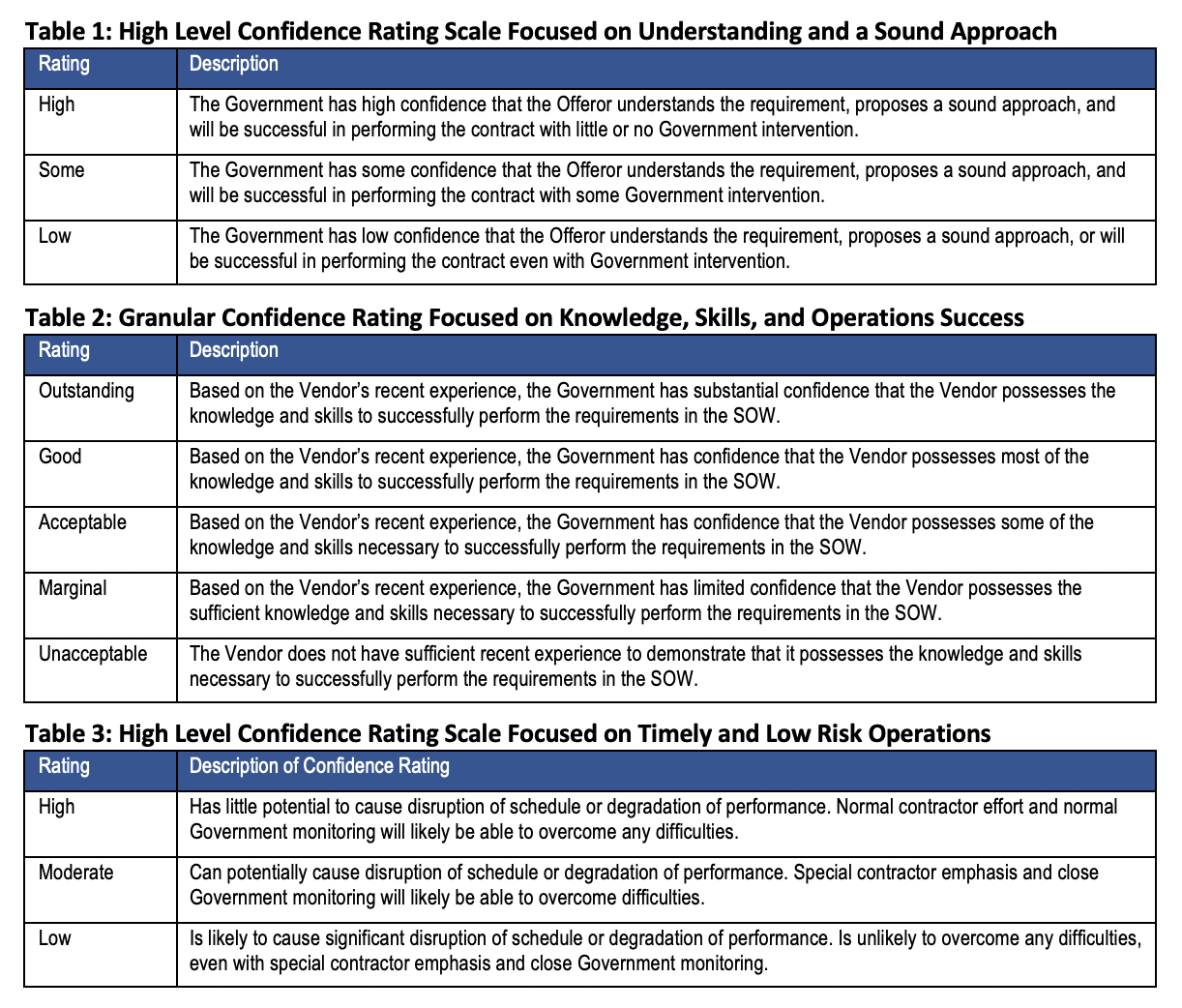Increase Your Confidence Rating Score
 If your proposal is evaluated in accordance with Federal Acquisition Regulation (FAR) subparts 8.4, 15.3, 16.505, and Part 13, the Government can use a confidence rating to score all or part of a proposal. Confidence ratings are another form of an adjectival rating. However, only FAR Subpart 15.3 requires documentation of relative strengths, deficiencies, significant weaknesses, and risks.
If your proposal is evaluated in accordance with Federal Acquisition Regulation (FAR) subparts 8.4, 15.3, 16.505, and Part 13, the Government can use a confidence rating to score all or part of a proposal. Confidence ratings are another form of an adjectival rating. However, only FAR Subpart 15.3 requires documentation of relative strengths, deficiencies, significant weaknesses, and risks.
The Government uses a confidence rating for several reasons. First, it may mitigate controversies associated with a more detailed adjectival (red, yellow, green, blue) or numeric scores. Second, it enables the Government to score the proposal holistically rather for a certain part of the proposal like the technical, management, past performance, or transition plan. Third, it makes it easier for the Source Selection Authority to rationalize a decision for an award.
The Government has the leeway to define adjectives applied to a confidence rating. The Government may use a high-level confidence rating such as high, medium, or low confidence (Table 1) or a more granular scale like substantial confidence, satisfactory confidence, neutral confidence, limited confidence, and no confidence (Table 2). The Government also has the leeway to assign a description to a confidence rating. For example, high confidence in Table 1 focuses on the offeror’s understanding, outstanding confidence in Table 2 focuses on experience, skills, and knowledge; and high confidence in Table 3 focuses on timely and low risk operations.

Assigning the Confidence Rating
The Government also has leeway in describing how it will assign a administer a its confidence rating; therefore, you must be discerning to maximize your rating(s). For instance, if the Government asks for three to five past performance references and indicates they are assigning a past performance reference to each reference, you may want to use only three past performance references that are highly relevant in terms of size, scope, and complexity. However, if the Government is assigning one score the combined past performance references, you may want to use up to five references that demonstrate high relevance in terms of size, scope, and complexity across all requirements.
If after assigning confidence factors to offerors, the Government has a tie between the two or more offerors with the same confidence ratings, the Government does not rank their confidence ratings, it awards the contract to the lowest price. Therefore, if the Government decides to use a high-level confidence ratings (low, medium, and high), it might be hard for them distinguish one bidder from another, because most offerors should be able to create a proposal with high scores. Therefore, it is important that offerors submit a highly competitive price.
Increasing Your Confidence Score
Although confidence scores give the Government wide leeway in selecting the winner, offerors who are mindful of the confidence rating and request for proposal instructions can increase their rating by providing specific and detailed information to support and substantiate their solution, which including the following.
- Explain how you transition the work and staff without disrupting ongoing operations
- Provide an accurate description of the size, scope of work and the associated risks, in addition to a clear description of the outcomes the Government wants to achieve
- Describe how your solution will produce successful mission outcomes, while minimizing risk
- Explain how reliably you will perform the work, minimize risk, and produce successful outcomes
- Describe how you will report the work and provide the customer with transparent insight into your status in comparison to service level agreements (SLAs), acceptable quality levels (AQLs) or other expectations
- Define how and why you will provide the right type, number and mix of staff
- Describe how you recruit, train, and retain staff (which is especially important for new work)
- Explain how you proactively identify, manage, control, and report on risk and performance
- Innovations that increase productivity, capacity availability at a tolerable risk level
To support the descriptions listed above, provide proof points that demonstrate you can implement your solution at a tolerable level of risk for the Government.
Strength and Confidence Scores
Although the confidence rating does not expressly ask for strengths, providing strength statements that demonstrate how you can meet/exceed the requirements at a tolerable level of risk can increase your confidence rating. Therefore, just because you are not measured against FAR Subpart 15.3 does not mean you should stop trying to define the strengths of your offeror, it only means the Government is evaluating your proposal using a different adjectival rating system
By Brenda Crist, Vice President at Lohfeld Consulting Group, MPA, CPP APMP Fellow
Lohfeld Consulting Group has proven results specializing in helping companies create winning captures and proposals.
As the premier capture and proposal services consulting firm focused exclusively on government markets, we provide expert assistance to government contractors in Capture Planning and Strategy, Proposal Management and Writing, Capture and Proposal Process and Infrastructure, and Training. In the last 3 years, we’ve supported over 550 proposals winning more than $170B for our clients—including the Top 10 government contractors. Lohfeld Consulting Group is your “go-to” capture and proposal source! Start winning by contacting us at www.lohfeldconsulting.com and join us on LinkedIn, Facebook, and Twitter.
Paperback or Kindle
10 steps to creating high-scoring proposals
by Bob Lohfeld
contributors Edited by Beth Wingate
Subscribe to our free ebrief
Teaming friends, frenemies, and enemies—12 tips to mitigate harmful effects
Did you know that contracting officers spend up to 20% of their time mitigating disputes between teaming partners? In an informal poll we conducted on LinkedIn last month, 40% of respondents classified their teaming partners as “frenemies” on their last bid.
Explore Further
- Advice (446)
- AI (5)
- APMP (17)
- Business Development (198)
- Capture Management (197)
- Favorite Books (5)
- Go-to-Market (27)
- Graphics (6)
- Lohfeld Books (3)
- Past Performance (58)
- Post-submission Phase (15)
- Pre-RFP Preparation (211)
- Proposal Management (270)
- Proposal Production (60)
- Proposal Reviews (27)
- Proposal Writing (77)
- Pursuit Phase (89)
- Research Report (2)
- Resources (60)
- Tools & Tips (259)
- Training (10)
- Uncategorized (220)

Sign Up for INSIGHTS and Download your FREE book
We'd love to help you with your proposals. Enjoy our complimentary Lohfeld Consulting Group Capture & Proposal Insights & Tips book with your FREE subscription to our Insights Newsletter.
GET YOUR FREE BOOK




